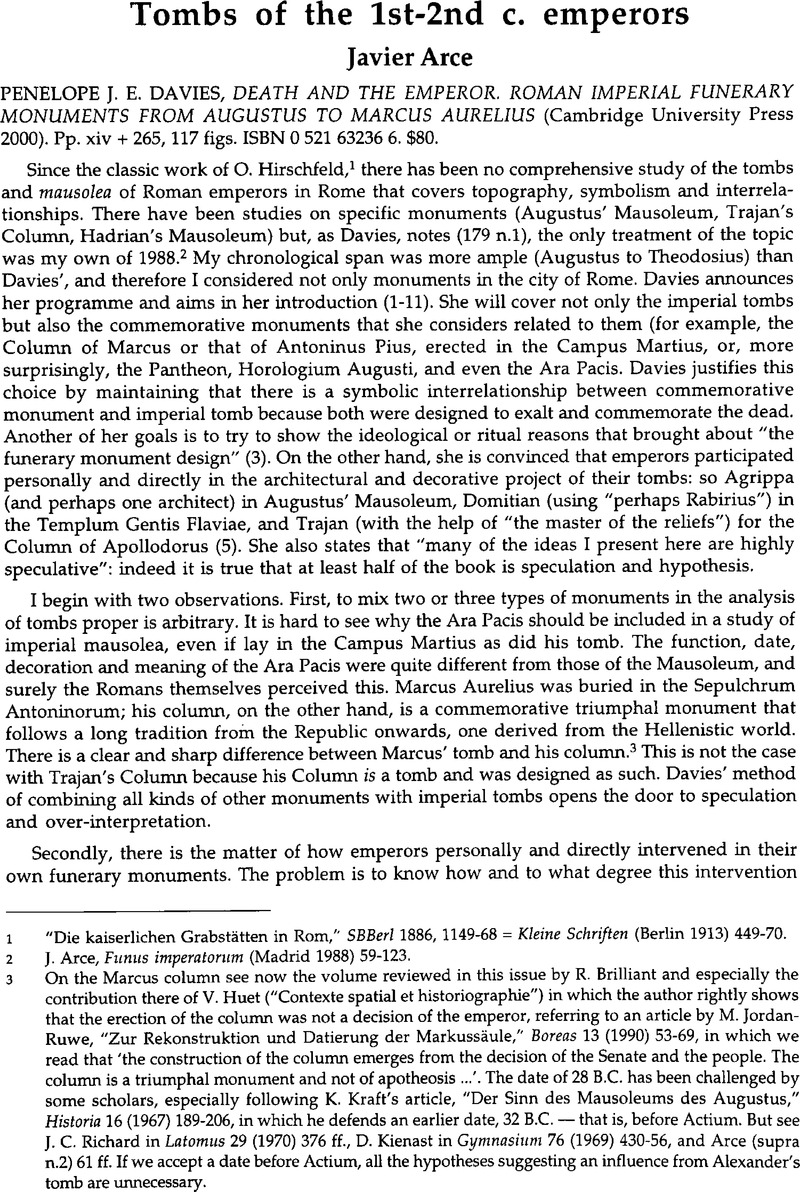No CrossRef data available.
Article contents
Tombs of the 1st-2nd c. emperors - Penelope J. E. Davies, DEATH AND THE EMPEROR. ROMAN IMPERIAL FUNERARY MONUMENTS FROM AUGUSTUS TO MARCUS AURELIUS (Cambridge University Press 2000). Pp. xiv + 265, 117 figs. ISBN 0 521 63236 6. $80.
Published online by Cambridge University Press: 16 February 2015
Abstract

- Type
- Reviews
- Information
- Copyright
- Copyright © Journal of Roman Archaeology L.L.C. 2002
References
1 “Die kaiserlichen Grabstätten in Rom,” SBBerl 1886, 1149–68Google Scholar = Kleine Schriften (Berlin 1913) 449–70Google Scholar.
2 Arce, J., Funus imperatorum (Madrid 1988) 59–123 Google Scholar.
3 On the Marcus column see now the volume reviewed in this issue by R. Brilliant and especially the contribution there of V. Huet (“Contexte spatial et historiographie”) in which the author rightly shows that the erection of the column was not a decision of the emperor, referring to an article by Jordan-Ruwe, M., “Zur Rekonstruktion und Datierung der Markussäule,” Boreas 13 (1990) 53–69 Google Scholar, in which we read that ‘the construction of the column emerges from the decision of the Senate and the people. The column is a triumphal monument and not of apotheosis The date of 28 B.C. has been challenged by some scholars, especially following Kraft's, K. article, “Der Sinn des Mausoleums des Augustus,” Historia 16 (1967) 189–206 Google Scholar, in which he defends an earlier date, 32 B.C. — that is, before Actium. But see Richard, J. C. in Latomus 29 (1970) 376 ff.Google Scholar, Kienast, D. in Gymnasium 76 (1969) 430–56, and Arce (supra n.2) 61 ffGoogle Scholar. If we accept a date before Actium, all the hypotheses suggesting an influence from Alexander's tomb are unnecessary.
4 Gonzalez, J., ZPE 55 (1984) 55–100 Google Scholar, frag. I, esp. 11.9 ff. See also Millar, F., “Imperial ideology in the Tabula Siarensis,” in Gonzalez, J. and Arce, J. (edd.), Estudios sobre la Tabula Siarensis (Anejos de ArchEspArq 9, 1988) 11–20 Google Scholar.
5 Richard, J. Cl., “‘Mausoleum’: d'Halicamasse à Rome, puis à Alexandrie,” Latomus 20 (1970) 383 Google Scholar.
6 Suet., , Aug. 101.6 Google Scholar: in aeneis tabulis quae ante Mausoleum statuerentur.
7 Surely he did not if we accept the proposal of Claridge, A. in JRA 6 (1993) 5–22 Google Scholar.
8 Pfanner, M., Der Titasbogen (Mainz 1983)Google Scholar.
9 This is surely not the one published in von Hesberg, H. and Panciera, S., Das Mausoleum des Augustus (München 1994) Abb. 49Google Scholar. See now Buchner, E., Antike Welt 27 (1996) 163 fig. 3Google Scholar.
10 Dio 56.33 speaks of estelai.
10 secutaeque aetates alios transtulerunt … duo in Augusti monumento erecti sunt. For details and bibliography see Arce (supra n.2) 63 n.10. Contra: Boschung, D., “Tumulus Iuliorum – Mausoleum Augusti. Ein Beitrag zu seinem Sinnbezügen” Hefte Arch. Sem. Univ. Bern 6 (1980) 36–41 Google Scholar.
12 See the discussion by Richard (supra n.5) and Arce (supra n.2) 69 ff.
13 Was Vespasian buried in the Mausoleum or in the Templum Gentis Flaviae? Vespasian: Arce (supra n.2) 78; Nerva: ibid. 83; Julia Domna: ibid. 93-94.
14 In von Hesberg and Panciera (supra n.9) 72 n.3
15 Coarelli, F. and Thébert, Y., MEFRA 100 (1988) 761–818 CrossRefGoogle Scholar, with bibliography. On the attitude of Augustus to Alexander, it is worth noting that, if it is true that during his triumvirate Octavian used the image of the sphinx and the portrait of Alexander in his personal ring, he changed them when proclaimed Augustus, thereafter using his own image. Thus Augustus' attitude was, at the least, ambiguous: see Voisin, J. L., “ Exoriente sole (Suet., Nero 6). D'Alexandrie à la Domus Aurea,” in L'Urbs (CollEFR 98, 1987) 532 n.84.Google Scholar
16 Gagé, J., Res Gestae (Paris 1977) 28–31 Google Scholar.
17 Zanker, P., Augustus and the power of images (Ann Arbor 1988) 144 Google Scholar.
18 Ibid.
19 This follows Coarelli, F., “L'apoteosi di Augusto e l'apoteosi di Romolo,” AnalRom Suppl. 10 (1983) 41–46 Google Scholar.
20 Gros, P., Aurea tempia (BEFAR 231, 1976) 143 ff.Google Scholar, a book not fully exploited by Davies; but see now D., and Gruben, G., “Die Türe des Pantheon,” RômMitt 104 (1997) 3–74 Google Scholar. A circular courtyard is not a circular temple.




